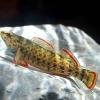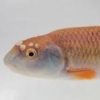Rainbow shiners in a 29G?
#1
 Guest_Sticklematt_*
Guest_Sticklematt_*
Posted 18 November 2010 - 03:35 AM
Fishbase says they can reach 3 inches in size, which has me concerned the tank won't be long enough.
Currently the tank has no plants, though I'd love to add a few plants appropriate to the streams where these shiners live in the wild.
Any help would be appreciated!
#2
 Guest_EricaWieser_*
Guest_EricaWieser_*
Posted 18 November 2010 - 05:48 AM
This'll explain what I'm talking about:
What is color temperature? Link that explains: http://en.wikipedia....lor_temperature
Gravel, soil, fluorite, kitty litter mineral analysis: http://www.thekrib.c...rate-jamie.html
Edit: Oh, and to make plant suggestions I would also like to know your pH and degrees of General Hardness (GH).
Edited by EricaWieser, 18 November 2010 - 05:50 AM.
#3
 Guest_Sticklematt_*
Guest_Sticklematt_*
Posted 18 November 2010 - 05:53 AM
What substrate and lighting do you have? That would determine what species of plants would do best. In particular, I would like to know what color temperature your bulbs are and whether your substrate has any more minerals in it than silicon dioxide.
This'll explain what I'm talking about:
What is color temperature? Link that explains: http://en.wikipedia....lor_temperature
Gravel, soil, fluorite, kitty litter mineral analysis: http://www.thekrib.c...rate-jamie.html
Edit: Oh, and to make plant suggestions I would also like to know your pH and degrees of General Hardness (GH).
The tank itself is just gravel, but any plants will be potted in ADA Aquasoil, and I fertilize the water column (Barr method), so nutrients should be fine. I don't do CO2 - it outgasses rapidly when you have tanks with lots of flow and surface disturbance.
In terms of pH, the water is hard and alkaline (which I understand is typical for the shiner biotope). I'm looking for plants that a) will grow in this environment and b) are actually found in streams with rainbow shiners.
Bulb color temp is daylight (65K).
Edited by Sticklematt, 18 November 2010 - 05:54 AM.
#4
 Guest_Newt_*
Guest_Newt_*
Posted 18 November 2010 - 01:00 PM
There's probably more aquatic plant diversity in some of the lower elevation streams in the southern part of its range. I don't know how crazy you want to go with your biotopic accuracy, but there are plenty of commonly sold aquarium plants native to the southeast.
#6

Posted 18 November 2010 - 04:16 PM
Let us know how it turns out.
#7
 Guest_Sticklematt_*
Guest_Sticklematt_*
Posted 18 November 2010 - 06:02 PM
I second the previous 2 comments. There were no plants in the stream as far up and down as I went when I collected my shiners in Tuscaloosa. I will agree with you that not much beats a planted tank but these guys aren't really found in such habitat. Not to steer you away from natives, but a planted tank with tetras would be more accurate. Search the forum on how to construct your own rock wall. Getting a tank to look like a natural stream is just as rewarding in my opinion.
Let us know how it turns out.
Thanks for the advice, everyone.
I don't want a serious planted tank - just a bit of vegetation behind a big boulder to help with water quality and to give a bit of green to contrast with the shiners' red. The vast majority of the tank is large boulders, cobbles, and gravel, with a bit of driftwood.
You can see the previous iteration of the tank here.
#8
 Guest_EricaWieser_*
Guest_EricaWieser_*
Posted 18 November 2010 - 09:45 PM
Newt's right, aquatic vegetation is minor in streams like Little Willis Creek outside Fort Payne, AL, where rainbows are common.
That's what I found online, too. This book on the Mobile river drainage has two sections on plants: types of algae and types of trees that grow on the shore.
http://books.google....etation&f=false
(rainbow shiners were endemic to the Mobile river drainage)
Here's a guide to the submersed plants of Alabama: http://www.outdooral...uide/submersed/
Ooh, look, Ceratophyllum.
Since your water is hard and alkaline, I would avoid Cabomba caroliniana. In my water (pH 8.5, 10 degrees of hardness), the cabomba just melted away and died. The Ceratophyllum loves it, though. A bit too much, I think.
Edited by EricaWieser, 18 November 2010 - 09:58 PM.
#9
 Guest_Sticklematt_*
Guest_Sticklematt_*
Posted 18 November 2010 - 11:17 PM
That's what I found online, too. This book on the Mobile river drainage has two sections on plants: types of algae and types of trees that grow on the shore.
http://books.google....etation&f=false
(rainbow shiners were endemic to the Mobile river drainage)
Here's a guide to the submersed plants of Alabama: http://www.outdooral...uide/submersed/
Ooh, look, Ceratophyllum.
Since your water is hard and alkaline, I would avoid Cabomba caroliniana. In my water (pH 8.5, 10 degrees of hardness), the cabomba just melted away and died. The Ceratophyllum loves it, though. A bit too much, I think.
If cladophora wasn't automatically associated with poor aquarium maintenance I'd consider it. I have Ceratophyllum in lots of tanks because it's such a good nitrate sponge, but I've never seen it in a fast-flowing stream. I have seen E. canadensis before though, as well as sago pondweed (S. pectinata).
#11
 Guest_EricaWieser_*
Guest_EricaWieser_*
Posted 19 November 2010 - 12:18 AM
If cladophora wasn't automatically associated with poor aquarium maintenance I'd consider it.
Cladophora grows on stuff, like rocks and branches:
http://showcase.aqua...04/View/441.jpg
It can cling to your stream rocks.
Edited by EricaWieser, 19 November 2010 - 12:19 AM.
#12
 Guest_Sticklematt_*
Guest_Sticklematt_*
Posted 19 November 2010 - 01:10 AM
Cladophora grows on stuff, like rocks and branches:
http://showcase.aqua...04/View/441.jpg
It can cling to your stream rocks.
That stuff looks really good. Most of the Cladophora that pops up in my tanks looks more like a mass of green hair, and it's a pain to remove.
#13

Posted 19 November 2010 - 01:03 PM
also, depending on your flow, you may find 'dead spots' that some might object to, but a plant might appreciate... I have some areas of my tanks that have some flow, but have such dead spots and you can keep plants quite happy in these spaces... but I am not enough of a flow engineer to predict them, I just find them through observation after the fact... someitmes the plants themselves find them... 'walking' across the sand a ways to find the best habitat...
#14
 Guest_EricaWieser_*
Guest_EricaWieser_*
Posted 21 November 2010 - 08:27 PM
You can use dental floss or fishing line to tie the cladophora down onto the branches at first.That stuff looks really good. Most of the Cladophora that pops up in my tanks looks more like a mass of green hair, and it's a pain to remove.
But really, I think you should find a plant to your liking on the state's aquatic plant list. http://www.outdooral...uide/submersed/
Ceratophyllum demersum is one of my favorite plants ever; I wrap it around a rectangular PVC frame and it looks like it's rooted, but it's not. You can see the PVC frame exposed in this photo: http://img.photobuck...imiru/001-1.jpg
In the current photo of my tank you can't even tell there's a PVC frame holding the ceratophyllum down: http://img.photobuck...imiru/006-3.jpg
Edited by EricaWieser, 21 November 2010 - 08:38 PM.
#15
 Guest_Sticklematt_*
Guest_Sticklematt_*
Posted 21 November 2010 - 08:34 PM
You can use dental floss or fishing line to tie the cladophora down onto the branches at first.
But really, I think you should find a plant to your liking on the state's aquatic plant list. http://www.outdooral...uide/submersed/
Ceratophyllum demersum is one of my favorite plants ever; I wrap it around a rectangular PVC frame and it looks like it's rooted, but it's not. You can see the PVC frame exposed in this photo: http://img.photobuck...imiru/001-1.jpg
In the current photo of my tank you can't even tell there's a PVC frame holding the ceratophyllum down: http://img.photobuck...imiru/006-3.jpg
Oh, don't get me wrong, I love hornwort - it does very well in my hard water, and it's currently in no fewer than four tanks, plus an outside pond.
Hornwort just isn't a stream plant, though. It breaks down very easily and won't stay anchored with my tank's current. I've considered some Vallisneria americana - it actually does grow in streams sometimes, when it can find a "safe" spot behind a large rock.
#16
 Guest_EricaWieser_*
Guest_EricaWieser_*
Posted 21 November 2010 - 08:36 PM
Widgeon grass is probably the closest Alabama equivalent to Vallisneria. http://www.outdooral...d/ruppiaspp.cfmOh, don't get me wrong, I love hornwort - it does very well in my hard water, and it's currently in no fewer than four tanks, plus an outside pond.
Hornwort just isn't a stream plant, though. It breaks down very easily and won't stay anchored with my tank's current. I've considered some Vallisneria americana - it actually does grow in streams sometimes, when it can find a "safe" spot behind a large rock.
Or Eel Grass: http://www.outdooral...allisneriaa.cfm
Creeping rush would probably be able to hold up in a strong current, look at its root system: http://www.outdooral...sed/juncusr.cfm
#17
 Guest_Sticklematt_*
Guest_Sticklematt_*
Posted 21 November 2010 - 08:45 PM
Widgeon grass is probably the closest Alabama equivalent to Vallisneria. http://www.outdooral...d/ruppiaspp.cfm
Or Eel Grass: http://www.outdooral...allisneriaa.cfm
Creeping rush would probably be able to hold up in a strong current, look at its root system: http://www.outdooral...sed/juncusr.cfm
That Juncus is nice, and I'll bet I could get it to root if I placed it behind the big rock in that tank.
I've never actually seen the stuff in a stream, though. I have seen V. americana hanging on behind large rocks where the current is slower, and according to that guide it is actually found in Alabama. I find it all the time when I visit Florida.
Edited by Sticklematt, 21 November 2010 - 08:47 PM.
#18
 Guest_Newt_*
Guest_Newt_*
Posted 22 November 2010 - 11:56 AM
Najas, Potamogeton, and Ludwigia do well in moderate current and often grow there naturally, as do various mosses. If you pot the plants up with some finer substrate they should do well.
#19
 Guest_nativeplanter_*
Guest_nativeplanter_*
Posted 22 November 2010 - 12:13 PM
Reply to this topic
1 user(s) are reading this topic
0 members, 1 guests, 0 anonymous users










